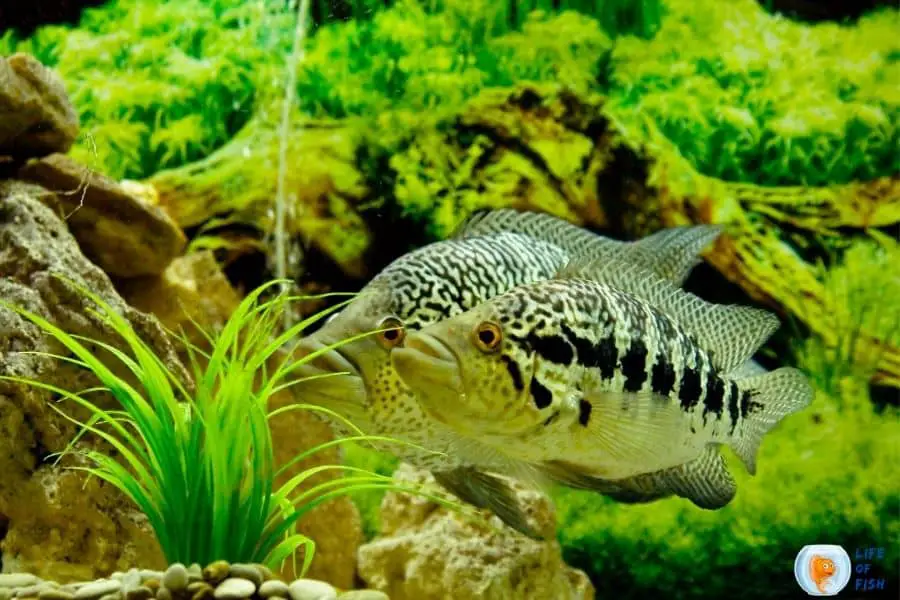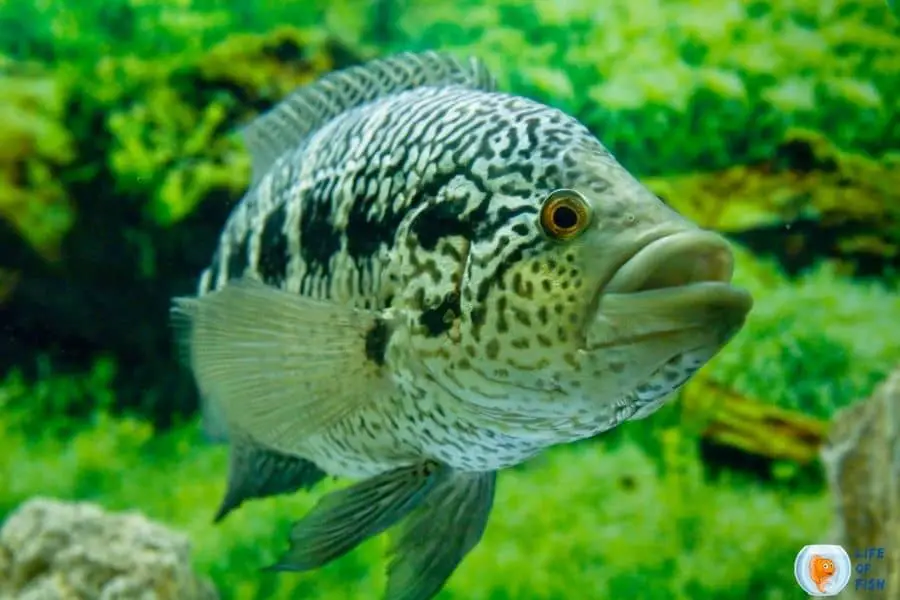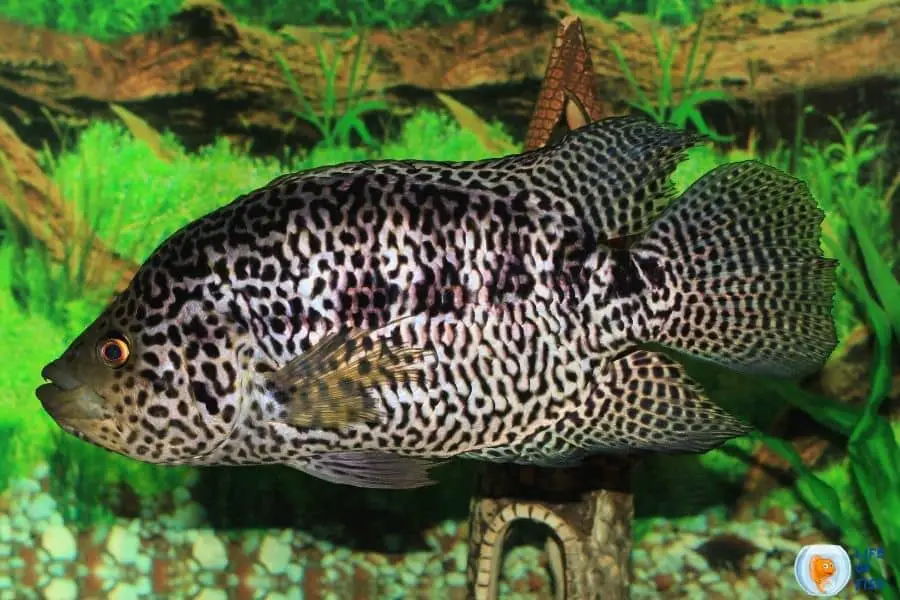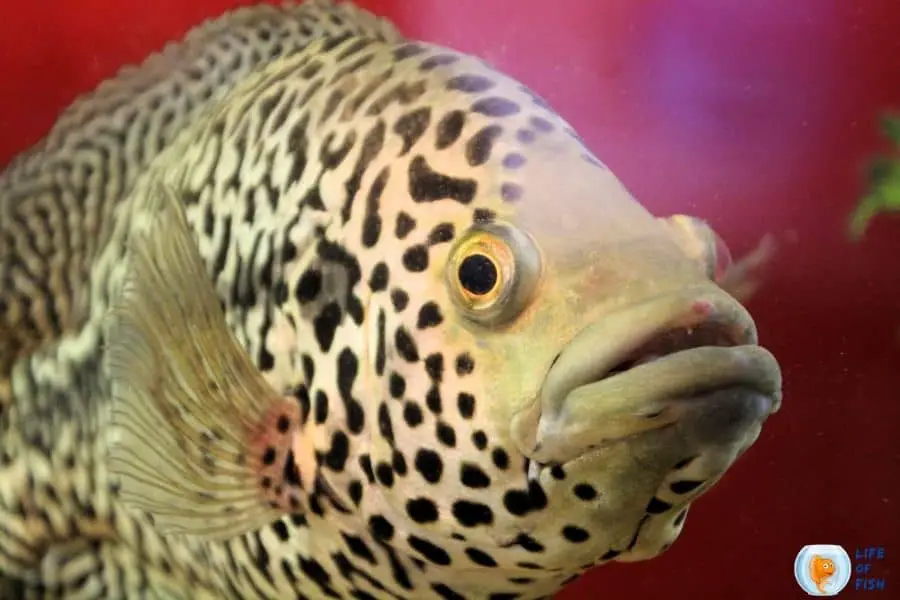Jaguar Cichlid is a popular freshwater species among many aquarists for its stunning appearance. Some aquarists called them Managuense Cichlids or Aztec Cichlids.
They are hardy and can adapt to many conditions in various environments, including fast-moving streams, waters with thick vegetation, calm lakes and even conditions with low dissolved conditions.
The locals of Central America, where these fish are originally found, often refer to them as Guapote Tigre.

They are native to Central America. They spread throughout freshwater bodies in Honduras, Costa Rica, Mexico, Panama, and as far away as Florida and Singapore due to importation and the aquarium trade.
As the name suggests, these large fish are fierce predators and have a distinct profile made for hunting. They have an elongated body that takes on an oval shape.
They have spiny rays extending from their bodies which give them a fearful appearance. The most prominent feature of this fish is its head and mouth.
The jaws of the Jaguar Cichlid protrude as much as 90% of its mouth’s length allowing them to pray large prays.
Their lower jaw extends beyond the upper jaw a bit. This special adaptation does not only help to increase their fierce appearance but also helps them to hunt easily. Because of the longer lower jaw, you can clearly see its sharp teeth.
The Jaguar Cichlids can change their appearance as they age. They are pale goldish-silver color when they are juvenile and have large black strips around the back of the fish and it extends until the lateral line of the fish.
When they become mature the lack lines slowly turn into dots which give them an iconic jaguar color pattern. These dots again turned into black splotches by the time.
As the name suggests they are members of the family of Cichlidae and are scientifically named Parachromis managuensis . The latter part of its name comes from Lake Managua in Nicaragua, where they were originally found.
How big do Jaguar Cichlids get?
Jump To
- 1 How big do Jaguar Cichlids get?
- 2 Is Jaguar Cichlid aggressive?
- 3 Jaguar Cichlid behavior
- 4 How long do Jaguar Cichlids live?
- 5 One look Care guide
- 6 Jaguar Cichlid care
- 7 Jaguar Cichlid breeding
- 8 Diseases
- 9 Feeding behavior of Jaguar Cichlid
- 10 What fish can live with Jaguar Cichlid?
- 11 Related questions
These are quite larger fish. They can reach the length of 14-16 inches when they are in captivity.
The female Jaguar Cichlid is two inches shorter than the males, in general. When they are in their natural environment they can reach a length of 2 feet and weigh nearly 3 pounds.
However, which size your Jaguar cichlid gets is depend on the aquarium conditions, and if there is enough space and optimum water quality conditions, they can grow larger. You might be able to see a cichlid who surpasses the 19 inches mark.
Is Jaguar Cichlid aggressive?
Yes, they are very aggressive fish. They are fierce predators and not reluctant to pick any fish in the tank. They will eat smaller fish and even invertebrates. Therefore, they are not a good match for a community tank.
Apart from their very aggressive temperament, they are highly territorial too. They will not let any fish go across their territory and such a fight may end up by killing the smaller fish.
However, juvenile Jaguar Cichlids are not aggressive like their mature individuals.
Jaguar Cichlid behavior
Generally, they prefer the bottom half of the aquarium and often you can see they swim around very actively. They also dig the substrate.
As described earlier, they are very aggressive and territorial by nature. However, you can minimize its aggressive behavior a little bit by keeping optimum water quality conditions and providing them with a healthy diet.
How long do Jaguar Cichlids live?
The average lifespan of the Jaguar Cichlid is around 15 years in captivity. According to the aquarists, you can increase its lifespan by maybe 3 -4 years by keeping optimum water quality conditions and providing them with a healthy diet.

One look Care guide
| Scientific name | Parachromis managuensis |
| Common name | Managuense Cichlids or Aztec Cichlids,Jaguar cichlids |
| Care level | Moderate to hard |
| Native to | Central America |
| Type | Freshwater |
| Color | Black and white |
| Tank size | 70 gallons |
| Prefered temperature | 73°F to 82°F |
| Other water parameters (ammonia ,ect) | pH : 7.0 to 8.7Hardness:10-15 dGH |
| Prefered salinity | Freshwater |
| Size | 14- 16 inches in captivity ,2 feet in the wild |
| Growth rate | Very fast |
| Temperament | Very aggressive |
| Recommended tank mates | Jaguar cichlid Oscar fish Green Terror cichlid convict cichlid Red devil cichlid Flowerhrn cichlid |
| Prefered food | Carnivorous food |
| Feeding frequency | Once a day |
| Breeding | Egg layers, easy to breed in captivity |
Jaguar Cichlid care
Jaguar Cichlid size
They are large fish species, like many other cichlid species.
They can reach the length of 14 to 16 inches (36 to 41 cm) when they are in captivity and the maximum length reported in the wild is two feet (60 cm).
Jaguar Cichlid tank size
The tank size for a Jaguar cichlid depends on its size and its age. However, it is better to use a large aquarium for these fish because they grow larger.
Generally, 30 gallons tank is enough for a juvenile fish. As they grow rapidly, you better put it in a tank of 70 gallons.
It is the very minimum tank size for a single cichlid and the tank size of 100 gallons is better. Lager tank size, minimize the stress of the fish as it has plenty of room to swim freely. Indirectly, larger spaces help fish to grow healthier.
If you plan to keep two cichlids for breeding purposes 180 gallons or a larger tank will be needed. Although they are already paired, they can still be aggressive.
Providing a larger space will minimize the harm of fighting as they can keep their own territory.
How many Jaguar Cichlids should be kept together?
As with many other cichlid species, Jaguar cichlid is aggressive toward the same species. However, you can keep a pair of them in a larger tank.
You can buy already bonded pairs from the shop or you can keep 4-5 juvenile cichlids together for some time period and get the pairs. The juvenile Jaguar cichlids are not aggressive as their adults.
Although you put an already paired couple, you must keep an eye on them as they can also fight.
Some aquarists suggest a 1:3 male-female combination is good for cichlids, this is hard to apply to Jaguar cichlids as they are large in size and are very aggressive.
Tank setup
The best way to set up the tank is to set it in its natural environment. Their natural environment is lakes, ponds, and rivers which are usually murky and filled with plant debris.
Therefore, you can decorate the tank with some plants, driftwoods, and rocks. When you plan for the vegetation use only floating aquarium plants as these fish dig the substrate and let your plants float. If you really need to install root plants, protect them by keeping them in pots.
The best substrate for Jaguar cichlid is the sand or fine gravel substrate. They usually dig the substrate and therefore keeping a thick layer of sand is recommended. However, do not put gravels that fit their mouths as these fellows can swallow gravels too.
Further, they need some hiding spots and you can put a flat rock or a large cave system. These structures really help, if you are going to breed them.
Try to locate all those decorations around the perimeter of the tank keeping much space in the middle of the tank as it helps to give them a larger space to swim.
However, keep in mind not to overcrowd the aquarium with decorations.
Water quality condition
No matter how hardy the Jaguar Cichlids are, they are very sensitive to water conditions. Therefore, it is important to replicate the water quality of their natural habitat.
As these fish from Central America, need warm and relatively neutral water. However, these fish can tolerate water temperature more than other fish species. It is said they can even tolerate 97 0F.
However, it is good to stick within the recommended range and try to avoid large fluctuations. The warmer water can increase the stress and aggressiveness of Jaguar cichlids and, hence advised to keep the temperatures relatively moderate.
The pH level of the water should be in the range of 7.0 to 8.7 while 7.7 is the ideal pH value. 10 to 15 dGH water hardness is recommended.
In conclusion, the water temperature should be in the range of 73°F to 82°F while 75 °F to 77 °F is the best range. You can consider the installation of a water heater to keep the water temperature within the range.
A powerful filtration system is important to keep the water parameters in the recommended range.
As they are carnivorous, they generate high waste amounts which increase the ammonia and nitrate levels.
Therefore , equip the tank with a powerful filtration system. Choose the filter based on the size of the tank and generally large sump-style filters or a canister filter are recommended.
It is good if you can use a strong pump as it will replicate the fast water flow of its natural environment.
Finally, Keep in mind to siphon the bottom frequently to avoid the buildup of waste.

Jaguar Cichlid breeding
Jaguar Cichlid male or female identification
The males and females of this species can be identified after a close examination of their fins.
The males have extended dorsal and anal fins that stretch to a nice point. The most notable difference is their size. Generally, the males are quite larger than the females.
Identify pregnant Jaguar Cichlid and Jaguar Cichlid pregnancy stage
The pregnant Jaguar cichlid can be easily identified as they swell when they bear eggs.
Jaguar Cichlid breeding
Jaguar cichlid breeding is not hard. They find their partner and naturally pair off. Another plus point is that they are great parents.
Therefore, you don’t need to take much effort in breeding as well as take care of the eggs and frying. The female will even exhibit maternal behaviors as the tiny fry grow up.
During the breeding period, they exhibit more aggressive and territorial behavior than they were. By any chance, if you put a pair of Jaguar cichlids in a community tank with other fish, transfer the pair of cichlids to another large tank to minimize the harm to other fish.
Even you can trigger their breeding process with few alterations. They breed in their natural environment during the rainy season.
Performing 50 percent water changes a couple of times a week will resemble the rainy season. Raising the temperature a few degrees also works well.
It is easy to identify the swell-up females with eggs. During this time they need a flat rock or cave to lay the eggs.
They lay upwards of 2,000 orange eggs at once. Then the male cichlid fertilizes the eggs. It takes five to seven days for the eggs to hatch.
During this whole time period, the female stays close by and the male protects the entire area showing that they are good parents. At this point, they are very aggressive and territorial. The male tends to fight until death if any try to cross their territory.
When the fry comes out after hatching, the parents dig a pit in the sand and put the tiny fry into the pit. They watch over the fry more closely. It takes about one week to fry and swim freely.
Jaguar Cichlid fry care
Actually, since the jaguar cichlids are good parents you don’t have to worry about the fry care. Only feeding them with an appropriate meal like baby brine shrimp is enough.
However, it is good to move the parents from the tank at the point when the fry begins to swim freely in the tank.
Also, Change out 20 percent of the water every day.
Diseases
As they are hardy species, they are not prone to any unique diseases.
However, as with any other aquarium fish, you should keep in mind to continue proper water conditions and diet plans as any considerable changes can weaken the fish immunity system.
The most common disease is ich. Fortunately, it can be easily recovered by treating the water with medications but needs to be identified at its first stage.
Keep in mind to isolate the affected fish to ensure the health of other fish.
Feeding behavior of Jaguar Cichlid
What do they eat ( in the wild and in an aquarium)
They are predators and hence highly carnivorous fish. They feed on small fish, insects, crickets, worms and pretty much everything which falls into the water in their natural environment.
While providing them flakes, pellets and frozen foods try to feed them with live food like feeder fish, worms, etc.
These fish are opportunistic eaters and will readily consume anything to provide. It is important to train them to eat commercial flakes or pellets at a young age.
Keep in mind not to provide excess meals as it ruins the water quality of the aquarium.
How often should you feed
It is enough to feed them one time a day. However, fed them daily and stick to a regular feeding schedule
When should you feed (time of the day)
They are usually active during the day time and they should be fed during the daytime
How long they can go without food
They can go for two to three days without food. They don’t get food regularly when they are in their natural environment and their body adapted to it

What fish can live with Jaguar Cichlid?
Finding tank mates for Jaguar cichlid is not easy due to their aggressive behavior. Therefore, many aquarists suggest the most suitable tank mate for the Jaguar cichlid is another Jaguar cichlid.
Most of the time male and female pairs live peacefully in larger tanks.
Also, the juvenile Jaguar fish can be kept in the same tank as they are not aggressive as their adults
Small fish are not suitable for this species as tank mates as they will eat them in no time. However, some larger species like Oscar fish, Green Terror cichlid, convict cichlid, Red devil cichlid and Flowerhrn cichlid occasionally do well with Jaguar cichlids.
However, you should be very careful and always keep an eye on them when you put other species as tank mates.
Related questions
Is Jaguar Cichlid aggressive?
Yes, they are very aggressive towards the same species and other species too.
How big do Jaguar cichlids get?
They can reach to a maximum of 16 inches in captivity and 2 feet in their natural environment
Can Jaguar Cichlid live in a pond?
Yes, there is some possibility. As they are hardy fish they can adapt to different environments for some extent
Read Next : Gold Severums | The Golden Cichlid You Must Know | Red Devil Cichlid Or Devil Fish Care ( What You Should Know )
